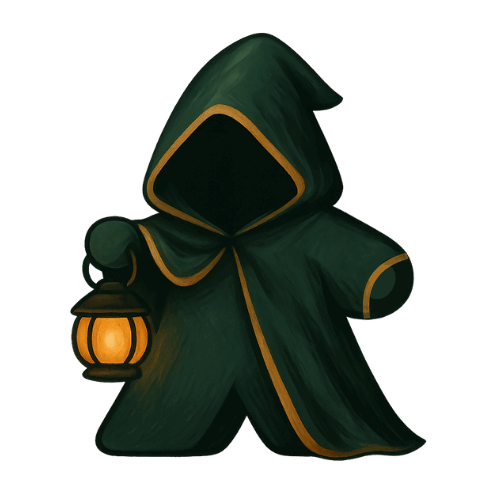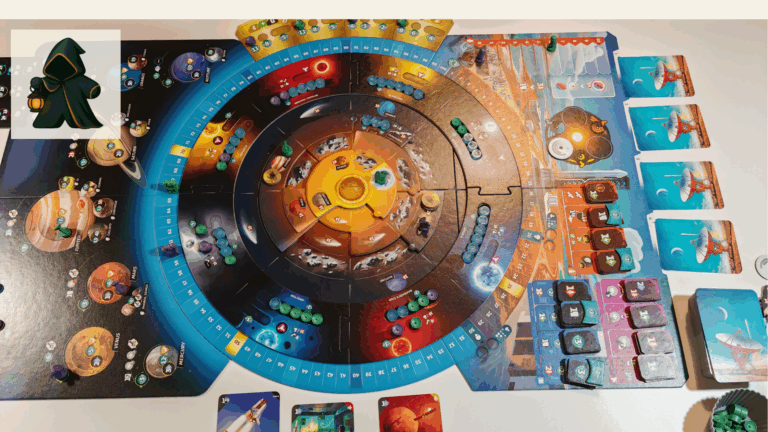I’m definitely always on the lookout for games that offer a great solo experience with a nice blend of strategy, beautiful artwork, and a balance between relaxing and challenging gameplay. So Harmonies caught my eye (and everyone else’s) when it came out. While some people keep comparing Harmonies to the Cascadia due to their nature themes and tile placement mechanics, I personally think they offer very different experiences. In this review, I’ll delve into what makes Harmonies a very nice choice for solo players. From its engaging gameplay mechanics to its stunning components, I’ll cover everything you need to know to decide if Harmonies should be your next board game purchase.

How to play Harmonies
In Harmonies you will build landscapes by placing coloured tokens and creating habitats for animals. The goal is to earn the most points by incorporating habitats wisely into your landscapes and settling as many animals as possible. Here’s a detailed look at how to play:
Game setup
- Central board and tokens: Place the central board. Shuffle the animal cards and place five cards face-up next to the central board. Place the rest of the cards nearby as the draw pile, and place the animal cubes within reach.
- Personal boards: Each player takes a personal board. Before you start you will decide which side of the board to use. And all players must play with the same side face-up. Each player also takes a reminder card displaying the side matching the personal boards.
- Token placement: Fill each of the spaces on the central board with three tokens drawn randomly from the pouch.
Game turn
These are the actions you can take each round. You can take these actions in the order of your choosing:
- Take and place tokens: Draw three tokens from any one space on the central board. Then place them on your personal board following specific placement rules. Tokens can be stacked to create trees, buildings, or mountains.
- Take an animal card: Choose one animal card from the five face-up cards and place it above your personal board. You can have up to four cards simultaneously.
- Place an animal cube: Place animal cubes on your personal board according to the habitat patterns depicted on the animal cards. Each animal card indicates the required pattern and the specific token colors needed to place the animal cubes.

End of game
The game ends when either the pouch is empty when you need to refill the central board, or there are two or fewer unoccupied spaces on any player’s personal board. At the end of the game, players tally their points based on the landscapes created and animals placed. The player with the most points wins!
Look and feel
The first thing you’ll notice about Harmonies is its breathtaking artwork and high-quality components. The game’s illustrator, Maëva Da Silva, has done a great job bringing the game’s theme to life. Each animal card is a piece of art, depicting various wildlife and landscapes in a serene and captivating style. The central board and personal boards are equally beautiful, featuring very chill illustrations that enhance the overall gaming experience.

Component quality
The quality of the components in Harmonies is pretty good. Here’s a breakdown:
- Tokens: The tokens are made out of colourful wood, printed with symbols. They feel very satisfying to handle and place on the board.
- Animal cards: The cards are printed on high-quality card stock with a smooth finish.
- Boards: Both the central and personal boards are of good quality with beautiful colours. They aren’t super thick so my player boards did arrive slightly bended but nothing that impedes gameplay.
- Animal cubes: The animal cubes are small but well-crafted, making them easy to handle and place accurately on the board.
- Pouch/cloth bag: Personally I haven’t run into problems yet. But the bag seems low quality and multiple people have complained about theirs falling apart after a few plays.
Overall, the components of Harmonies are good and the tokens, cubes combined with the beautiful artwork make for a very eye-catching game.
How to play Harmonies solo
Playing Harmonies solo is pretty straightforward as most of the standard rules also apply to the solo game. Here’s how you can enjoy Harmonies solo:
Solo setup
- Central board: Use the solo side of the central board, which has only three spaces instead of five.
- Animal cards: Place three animal cards face-up next to the central board.
- Token placement: As in the multiplayer game, fill each space on the central board with three tokens drawn randomly from the pouch.

Solo game turn
- Take and place tokens: Draw three tokens from any one space on the central board and place them on your personal board. The placement rules remain the same as in the multiplayer game.
- Take an animal card: You may choose one of the three face-up animal cards to place above your personal board. You can still have up to four cards simultaneously.
- Place an animal cube: Place animal cubes on your personal board according to the habitat patterns depicted on the animal cards.
Special solo rules
- Token refill: At the end of each turn, return the remaining six tokens to the box (they are discarded and not returned to the pouch). Then refill each of the three spaces with three new tokens.
- Animal card refresh: If you did not take an animal card during your turn, you may discard one animal card from the center of the table and replace it with the top card from the draw pile.
Scoring in solo mode
In solo mode, your goal is to earn as many suns as possible, representing your level of success during the game. The number of suns you get depends primarily on your score, but also on the side of the personal board used and the nature’s spirit card chosen at the start of the game. Aim to beat your high score in each configuration and challenge yourself to create the most harmonious landscapes possible.

What I think of the game
Harmonies is beautiful and well-crafted. The solo mode is almost identical to the multiplayer and requires no extra overhead while still challenging you on gameplay. It’s a very thinky game with lots of intricate moving parts to keep track of. But the cute art and animals still make it feel light. It’s definitely a case of the sum being more than the parts because when I was writing this review, I realized that all of this doesn’t sound that exciting or nice at all. But putting all of these coloured discs on top of each other to create intricate patterns and thinking of clever ways to score multiple animal cards at once makes for a very fun experience.
It’s sad that the solo is a beat your own score with very little scoring difference. I would have preferred if they just kept the scoring the same (so in the 150s range) instead of turning the score into a solo score (between 1 and 10 or so). It makes it feel less rewarding because going from a score of 6 to 7 just doesn’t feel very satisfying.
But that’s a minor detail for such a lovely game. I still calculate the solo score but pretty much just look at my “normal” score to see how I did and that’s fine for me. It definitely doesn’t detract from the strategic and fun gameplay that Harmonies offers.
Replayability and variability
Harmonies has multiple things going for it when it comes to variability, ensuring that the game remains engaging over multiple plays. Each game presents new challenges and opportunities due to the randomized setup and the variety of animal cards and tokens. The need to adapt to different token placements and habitat patterns keeps the gameplay fresh. Additionally, exploring different strategies, such as focusing on specific types of habitats or optimizing the placement of animal cubes for maximum points, provides you with multiple approaches to master. The inclusion of Nature’s Spirit cards adds another layer of variability. They encourage you to modify your strategies based on the unique bonuses these cards offer. Overall, the strategic depth and variability of Harmonies make it a game that you can return to repeatedly without it feeling repetitive.

Pros and cons
Pros:
- Beautiful artwork: The game features stunning illustrations by Maëva Da Silva, which greatly enhance the visual appeal and thematic immersion.
- High-quality components: From the colorful wooden tokens to the sturdy animal cards, the game pieces are well-crafted and satisfying to handle.
- Engaging solo mode: The solo gameplay is nearly identical to the multiplayer mode. It requires no additional rules while still providing a challenging experience.
- Strategic depth: Harmonies offers intricate gameplay with many moving parts, allowing for deep strategic planning and satisfying decision-making.
- Light and charming theme: Despite its complexity, the cute animal art and serene landscapes give the game a light and enjoyable atmosphere.
Cons:
- Solo scoring system: The solo mode uses a different scoring system that feels less rewarding, as it converts the score to a range between 1 and 10, which can feel less satisfying than the standard score range.
- Component issues: Some players have reported that the cloth bag provided for the tokens is of low quality and may wear out quickly. Plus the personal boards are not very thick, and some may arrive slightly bent, although this does not impact gameplay significantly.

Conclusion
In conclusion, Harmonies is a beautifully crafted and deeply engaging board game. It is great in both its solo and multiplayer modes. Its fun mechanics, combined with stunning artwork and high-quality components, create a rewarding and enjoyable gaming experience. While the solo scoring system might feel less satisfying to some, this minor thing does not overshadow the game’s strategic depth and replayability.
I highly recommend giving Harmonies a try. Immerse yourself in its charming world, explore its varied strategies, and see how your landscapes evolve with each game.


2 Comments